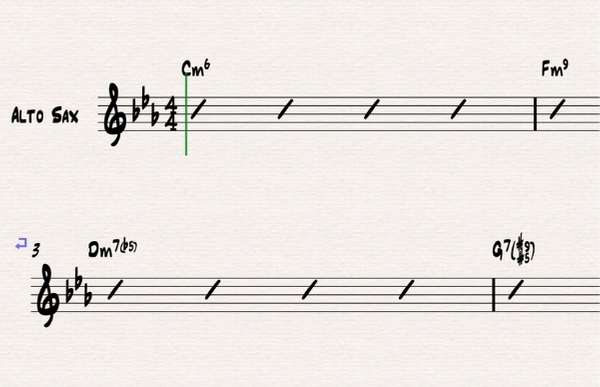Music theory is often called the building blocks of music. And while this is true, there is no doubt that theory can be quite confusing for new musicians, especially when it comes to applying it to all of the instruments of the band or orchestra. I thought I’d explain some of the broader aspects of music theory starting with a question I often see pop up, does music theory apply to all instruments?
In general, music theory is a universal concept of the building blocks of music. The main focus of theory covers notes, chords, transposing, rhythm, and cadence. All of these areas can be applied in some way to all instruments and understanding how theory works will help make you a better musician.

This is such a wide topic that can just lead to many more questions, so I’m going to try to break it down into what I think confuses the most people. A good rule of thumb is to always answer “yes” when asking yourself, “do I need to learn this or that about music theory?”
What Areas of Music Theory Don’t Apply To Me?
Typically, all areas of music theory can be applied to any instrument. This is because music theory isn’t about the playing of individual instruments, but how music is structured. From individual notes to chords, to rhythms, music theory is about the building blocks of music.
That was the textbook answer, but it is a true statement. Perhaps a more helpful way to look at it is to think about what you hope to gain by learning music theory.
If you want to learn how to play more complicated rhythms, then absorbing all you can about time signature and subdivision will help you accomplish that.
If you want to be the best jazz soloist you can, then learning chord structure and pitch relations is going to go a long way.
If you only want to be a casual player who only plays for yourself, then just learning how to read music and basic rhythms may be plenty for you.
Unless you plan to study music…and especially music theory…in college then you probably don’t need more advanced theory studies like form and analysis, figured bass, or counterpoint.
Am I Confusing Instrument Technique with Theory?
Some aspects of instrument technique can seem a lot like music theory. The two instruments that seem to confuse new players the most are the guitar and drums, likely because they do use some playing techniques that are similar in concept to music theory.
Guitar
Guitar players will need to learn chords and these chords are the same as piano chords or just chords in general. What might get confusing is the fact that a guitar player may structure the chords differently since they are relying on 6 strings to build the chords rather than the 88 keys a piano has at their disposal.
Rather than playing a chord, like C Major, as C-E-G, a guitar player may need to play the chord as E-G-C. This is called inverting the chord in music theory.
This is usually to facilitate a piece of music where the guitar player might be moving from chord to chord in such a way that he or she needs to simplify hand movement.
Drums
New rhythms and complex subdivision will likely come easier to a drummer than other instrumentalists…what makes playing the drums fun is learning these combinations of patterns and beats. Rhythm is an aspect of music theory.
What isn’t an aspect of music theory are the techniques a drummer uses to play these rhythms. Paradiddles, flams, and drags will allow a drummer to pull off some awesome-sounding music but they aren’t aspects of music theory.
What Basic Areas Of Music Theory Should I Learn?
For those that don’t want to learn all of the bits n’ pieces of music theory you might wonder if you should at least learn a little bit…but which little bit?
Those of you that may be starting band or orchestra good news, you’re already learning the fundamentals of music theory. You’re learning note names, how to read time signatures and key signatures, and how to play rhythms.
But if you’re not joining the school band and want to learn independently you may not learn those things in as structured of a manor or you may learn them in a different order.
It’s going to greatly depend on which instrument you’re learning, but any musician is going to be better if they learn note rhythms and subdivision and chord structure.
Rhythms and Subdivision
Knowing what a whole, half, quarter, eighth, etc note looks like and how to play is probably one of the most basic but also one of the most important things about music theory you can learn.
I had a teacher who once asked the class what the fundamentals of music were…people guessed but no one said the right thing (and this was a college music theory class.) Sound and Silence. And what are some of the basics of sound? Rhythm and Pulse.
Even if you play by ear having an understanding of what you’re playing is a must for anyone who wants to pursue music long term.
Subdivision is learning how the different note durations I mentioned above work in the time signature (also called meter) they are written in. A measure in 4/4 is subdivided differently than a measure in 3/4. Mainly because you have fewer beats to fill in 3/4.
If you’ve ever heard a band leader count in the group, (1,2, 1 and, 2 and, 3 and 4, and) then you’ve heard a basic use of subdivision. The numbers are the downbeats and the “and’s” are the upbeats…which indicate an eighth note pattern.

We can further subdivide by breaking notes into 16th notes. If counting out a rhythm it would be 1 e and uh, 2 e and uh, etc. We can, of course, divide further into 32nd notes and even further to 64th notes but for our purposes here we’ll keep it simple.

Chords
Drummers might be thinking, “but I don’t play notes…I play rhythms and patterns.” True, but as you get more advanced in your playing you may want (or need) to adjust the pitch of your bass drum or toms. Having an understanding of how chords work will allow you to make your drumming that much…extra. It can be what separates you from another drummer.
If you play a non-chordal instrument, like the saxophone, flute, or cello, developing your ear to recognize chords and how they progress from one to another can help you develop your ear to play in tune and can help you as an improvisational player. This is especially true for people that go into jazz performances.
In jazz, while you do have written music, solo sections will have measures that don’t contain notes but have slashes with chords written above them. These chords (called changes in jazz) will tell you what chords the rhythm section (piano, bass, guitar, and drums) are playing so that you can play a cohesive, awesome sounding solo.

Final Thoughts
Everything I’ve spoken about in this article barely scratches the surface of even the most basic concepts of music theory. Don’t let that overwhelm you though. As you start to learn the fundamentals, other aspects of theory will be easier to learn.
Learning note names leads to reading a music clef, this will lead to learning how to read other clefs. Learning how to subdivide in simple time signatures like 2/4, 3/4, and 4/4 will help you learn how to subdivide in more complicated time signatures like 6/8, 9/8, or 12/16.
Everything folds in to everything else. Don’t short your skill set by skipping out on learning music theory!
